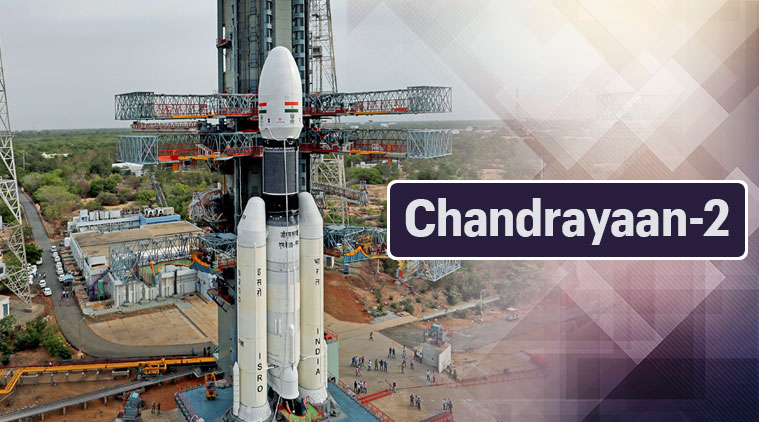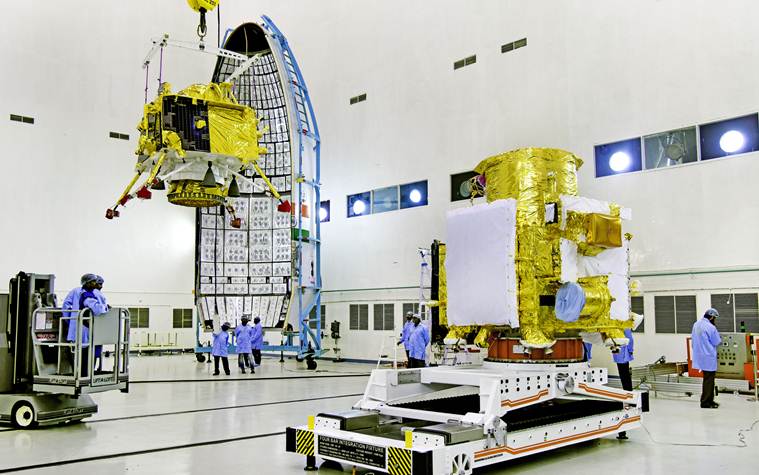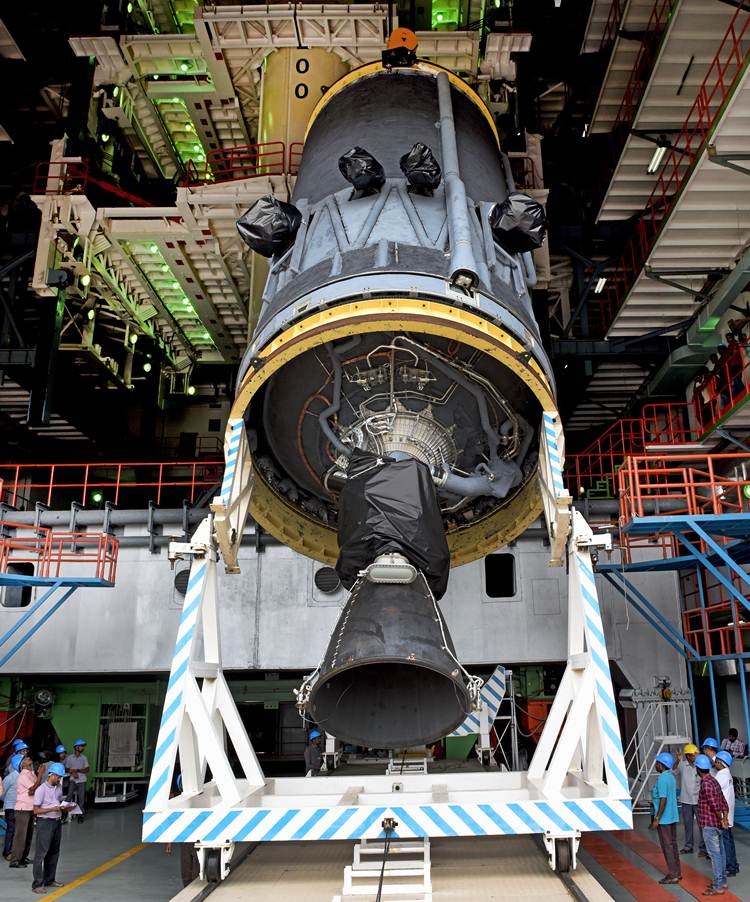
Chandrayaan-2 Launch: The Indian Space Research Organisation (ISRO) will launch Chandrayaan-2 on July 15 at 2:51 am from the Satish Dhawan space centre in Sriharikota.
The Chandrayaan-2, a moon-lander and rover mission, is designed to go where no spacecraft has gone before, near the south pole of the Moon. The unexplored region holds the maximum promise for presence of water as well as of fossil footprints that are said to hold information about the origins of the earth and the solar system. It is the Indian Space Research Organisation’s first mission to land on any celestial body, and a follow-up to Chandrayaan-1 launched in 2008.
Here’s a brief cheat sheet to all the space jargon you may hear for the next couple of days
Orbiter
Chandrayaan-2, a Rs 1,000-crore mission, consists of an Orbiter, Lander (named Vikram) and Rover (named Pragyan), all equipped with scientific instruments to study the moon. The Orbiter and the Lander will be attached to the GSLV MK-III rocket, the launch vehicle that throttle Chandrayaan into space and towards the Moon’s orbit.
Chandrayaan-2 Launch | Follow LIVE updates here
Once within the moon’s orbit, the lander will detach itself from the 2,379 kg Orbiter in order to make a soft landing on the lunar surface.

The Orbiter will continue to orbit around the moon and study its surface. The Orbiter contains a total of 8 instruments including Terrain Mapping Camera-2 (TMC-2), Miniature Synthetic Aperture Radar (Mini SAR) and Laser Retroreflector Array amongst others.
According to ISRO, the Chandrayaan-2 Orbiter will be capable of communicating with Indian Deep Space Network (IDSN) at Byalalu (in Karnataka) as well as with the Lander.The mission life of the Orbiter is one year and it will be placed in a 100X100 km lunar polar orbit.
Lander
Named after Vikram Sarabhai – the pioneer of India’s space programme, the Lander is a module that houses the Rover. After succesful landing on the lunar surface, it will deploy the Rover for conducting further experiments.

It is the first time that the ISRO is attempting to soft-land a module in extra-terrestrial space. Lander Vikram is designed to operate for 14 days (1 complete Lunar day). During this time, the 1,471 kg Lander which is capable of generating about 650 w of electricity will conduct its own experiments and will remain in constant communication with the IDSN.
India’s Chandrayaan-2 mission | All you need to know
With Chandrayaan-2, India will become only the fourth country to land a spacecraft on Moon.
Rover
Rover ‘Pragyan’, which means wisdom in Sanskrit, is the third and most important component of the Chandrayaan 2 mission. The 6-wheeled robotic vehicle can travel up to 500 metres and leverages solar energy for its functioning.
Once deployed, the rover will carry out experiments on the Lunar surface for a period of 1 Lunar day which is equal to 14 Earth days. Rover Pragyan has two vital instruments — Laser-Induced Breakdown Spectroscope (LIBS) and Alpha Particle Induced X-ray Spectroscope (APIXS) — that will test the surface of the moon in order to understand its mineral and chemical composition.
Launcher
The responsibility to power Chandrayaan into space rests upon the shoulder of ‘Baahubali’ – the country’s heaviest and most powerful launcher to date. The Geosynchronous Satellite Launch Vehicle (GSLV) Mark III is a three-stage heavy-lift launch vehicle developed by ISRO. The vehicle has two solid strap-ons, a core liquid booster and a cryogenic upper stage.
The GSLV is designed to carry a payload of 8,000 kg to LEO or Low Earth Orbit.
Geosynchronous Transfer Orbit (GTO)
A Geosynchronous Transfer Orbit is 35,786 kilometers above Earth’s equator. Satellites meant for weather monitoring, communications and surveillance are placed in this orbit so as to match Earth’s rotation.
Low Earth Orbit (LEO)
A Low Earth Orbit (LEO) is a Geo or Earth-centered orbit is at an altitude of 2,000 km. Most of the satellites are sent in this orbit as it requires the lowest amount of energy and is cost-efficient. The International Space Station is also in LEO.
GSLV Mk III

GSLV Mk III is a three-stage, heavy-lift launch vehicle developed by ISRO. The vehicle has two solid strap-ons or solid rocket boosters, a core liquid booster and a cryogenic upper stage.
Solid Rocket Boosters are large propellant motors that are used to provide additional thrust needed to during the launch process of a spacecraft. The additional thrust is needed to escape the gravitational pull of the Earth. The boosters, once launched, are separated from the external tank of the spacecraft at an altitude of approximately 45 km. They then descend on parachutes and are later refurbished for reuse.
Also read | Why the world’s in a second race to the moon
Chandrayaan’s launcher uses two S200 solid rocket boosters to provide the necessary thrust required for lift-off. The S200 was developed at Vikram Sarabhai Space Centre in Sriharikota.
Liquid Stage
The second stage rocket, also dubbed as L110 liquid stage, is powered by two ‘Vikas’ engines designed and developed at the Liquid Propulsion Systems Centre. These engines carry about 110 tonnes of fuel (Unsymmetrical dimethylhydrazine + Dinitrogen tetroxide).
These kinds of engines have been widely used by ISRO during various launches.
Cryogenic Stage

A cryogenic stage/engine is the last stage of space launch vehicle. The engine develops a thrust of 200 kN in a vacuum and is operational for a duration of 640 seconds. It uses a mixture of oxygen and hydrogen as its fuel. Chandrayaan’s C25 engine is powered by CE-20, India’s largest cryogenic engine, designed and developed by ISRO’s Liquid Propulsion Systems Centre.
Payload Fairing
The nose-shaped cone used at the top of a spacecraft is called Payload Fairing. It used to protect the spacecraft against the atmospheric pressure and heating.
Chandrayaan-2’s Mission Payloads
Chandrayaan-2 has several payloads in order to study different aspects of the Lunar planet. Some of them include:
Terrain Mapping Camera 2, a kind of mapping camera with a primary objective to map the lunar surface. A miniature version of this kind was earlier used onboard the Chandrayaan 1 mission.
Chandrayaan 2 Large Area Soft X-ray Spectrometer (CLASS), will be used to measure Moon’s X-ray Fluorescence (XRF) spectra to examine the presence of elements such as Magnesium, Aluminium, Silicon, Calcium, Titanium, Iron, and Sodium.
Orbiter High-Resolution Camera (OHRC) carried by Chandrayaan-2 aims to provide high-res images of the landing site from diferent angles.
Dual Frequency Synthetic Aperture Radar carried by Chandrayaan-2 will be used for a High-resolution lunar mapping in the polar regions.
Chandrayaan-2 Atmospheric Compositional Explorer or CHACE 2‘s primary objective is to carry out an in-situ study of the composition and distribution of the lunar neutral exosphere and its variability.
Dual Frequency Radio Science (DFRS) experiment will be used to study the temporal evolution of electron density in the Lunar ionosphere.